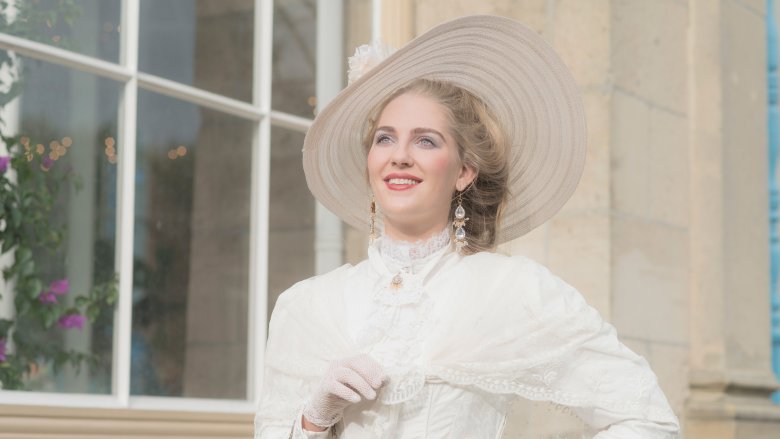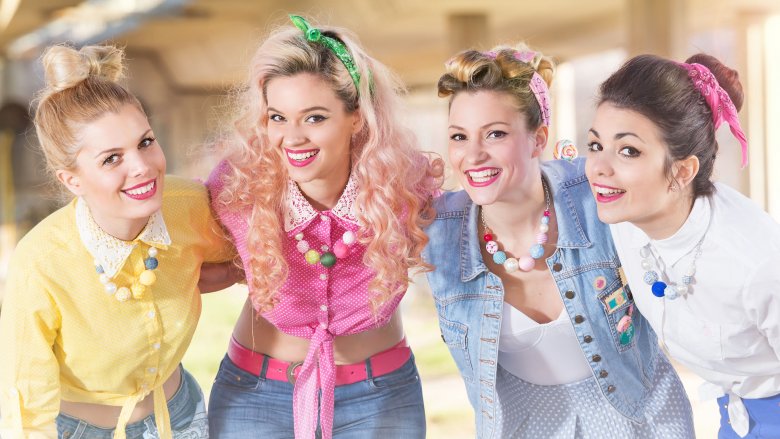How Standards For 'Healthy Bodies' Have Changed Throughout History
When you hear the term 'healthy body,' most likely, an image of some sort pops into your head. The image might be of someone who looks like you, it might be someone who looks the opposite of you, it could be someone bulging with muscles or a specific body mass index (BMI), or something else entirely. It could be based on or influenced by your own body image and self-esteem, or not. It could be based on your upbringing or the bodies of the people you see all around you. You and I may not even agree as to what a 'healthy body' looks like, exactly.
Society's idea of what makes a 'healthy body' has changed and evolved (or devolved, depending on how you feel about it) over time. At one point, a more voluptuous hourglass figure was prized, and then a thin, more angular look was the one for which to strive. 'Healthy' was skinny, 'healthy' was strong, 'healthy' was based on the diet you ate. The standards for a 'healthy' and 'attractive' body changed, seemingly, with the wind. Body ideals can change depending on the starlet of the era, the prevailing public political figures, or the pop stars, fashion icons, or 'It' girls of the moment.
Though what's old is often new again when it comes to trends and fads, the standards for 'healthy bodies' have fluctuated back and forth between slender and full-figured (and everywhere in between) for thousands of years.
Healthy teeth
While dental health and hygiene weren't exactly as involved as they are today, relatively recent excavations at Pompeii showed that ancient Romans had exceptionally healthy teeth, thanks to their nearly no-sugar diet, as bioarchaeologist Kristina Killgrove wrote in piece she contributed to Forbes. As Killgrove pointed out, there wasn't one overarching diet in ancient Rome, given the size and scope of the empire and the frequency with which all kinds of foodstuffs were exchanged. Still, many who lived in the Roman Empire ate, essentially, what today would be known as the Mediterranean Diet, featuring fresh fruits and vegetables, lean proteins (like fish, chickpeas, and lentils), whole grains, olives and olive oil, and red wine, though Killgrove noted that regular Romans living in poorer towns and villages also likely ate pork on a fairly regular basis. As a result, perhaps, of their diet, nearly none of them had any dental cavities.
Without floss, toothpaste, or toothbrushes, which now are considered practically essential for good dental health, ancient Romans managed to couple a healthy diet and lifestyle with very healthy teeth.
A strong body
In the Middle Ages, healthy people were often shorter than they are today, but they similarly would have experienced fewer dental issues and cavities because of their lower sugar diet, as Tim O'Neill, a contributor to Slate, Forbes, and Huffington Post, wrote on Quora. Additionally, according to the website for The British Library, women often were responsible for all of the household chores and/or worked alongside their husbands in the fields (if they weren't exceptionally wealthy). For this reason, they were likely relatively strong and muscular. Interestingly, single women typically wore their hair loose, while married women wore theirs up and covered with a cloth.
Better posture
In the 18th century, the concept of healthy bodies began to change. According to a University of Exeter (U.K.) press release, Dr. Alun Withey, a University of Exeter historian, wrote in his book Technology, Self-Fashioning, and Politeness in Eighteenth-Century Britain that during this period, people began to attempt to improve their posture as well as utilize grooming gadgets like nail clippers and tweezers.
Healthy land, healthy bodies
According to the History Channel's website, women in Victorian England wore corsets to promote healthy posture. Additionally, wearing corsets was thought to keep a woman's internal organs in their proper placements, important for healthy bodies.
Across the Atlantic Ocean, pioneers moving West believed that there was a connection between the health of the land on which they lived and the health of their bodies, according to a post on the Washington University in St. Louis (WUSTL) website. WUSTL environmental historian Conevery Bolton Valencius, Ph.D., who is also an associate professor of history, noticed that settlers and newspapers regularly referenced the health of the land. The idea was that if the pioneers decided to settle in a place where the land was considered healthy, then they and their families would be healthy as well.
The Gibson Girl ideal
In the 20th century (and nearly through to present day), the standards for healthy bodies were largely tied to beauty standards. In the early beginnings of the 20th century, for example, so-called Gibson Girls — tall, poised, and with hourglass figures — were the epitome of perfection. Gibson Girls were physically active and valued good health. That part of their characterization undoubtedly helped to shape the concept of what a healthy body was, as well.
Not so skinny
When the stock market crashed, the Great Depression set in, and war broke out, the slim and slender look that had been popular during the roaring '20s was no longer deemed healthy or ideal. In fact, advertisements ran commenting on how to avoid the pitfalls of being too skinny. Skinny bodies were in many cases the norm, however, during the Depression, as families struggled to secure adequate food.
Unattainable beauty
According to Medical Daily, mid-century women were battling an idealized beauty and body type that was pretty much unattainable for the average American woman. Artists, magazines, and the like were retouching photos of glamour girls and pin-up girls. The wider society chastised skinnier women, arguing that single skinny women would have more romantic success if they put on a few pounds. Healthy and beautiful were also said to be synonymous with dewy, unblemished skin.
'Healthy' was also increasingly correlated with one's diet. According to Shape, vegetarianism enjoyed an increase in popularity in the 1960s. While vegetarianism can be quite healthy if the focus is on lots of fruits, vegetables, plant protein, and whole grains, some vegetarians choose higher calorie 'comfort foods,' which often aren't as nutritious. It's important to remember that just because one eats according to the healthy diet that's in vogue at the time, it doesn't mean that you can truly tell how healthy or physically fit the person is.
Low calories, low fat
In the 1970s and 1980s, the gap in body mass index (BMI) between average women and beauty icons continued to widen. Low-calorie and low-fat diets were considered healthy, according to Shape. This meant that, if followed strictly, women weren't getting adequate amounts of some of the nutrients they needed. Aerobics became another sign of 'healthy,' with Jane Fonda becoming, arguably, the face of the craze, as noted by StyleCaster. Healthy bodies worked out regularly, often incorporating lots of cardio and toning exercises.
Additionally, as shown in ads featured on the website Go Retro!, from about mid-century on through the '80s (in particular), people associated healthy bodies with a bronzed, caramel-colored tan. Whiling away summer days poolside, applying tanning oils, and coaxing skin darker and darker was seen as something healthy people did. Times have changed.
Diet and exercise
In the 1990s and 2000s, it seemed like everyone embraced low carb diets like Atkins and the South Beach Diet in an effort to attain a healthy body. Carbs were unconsidered something unhealthy people ate. Additionally, the 2005 Dietary Guidelines for Americans recommended at least 30 minutes of exercise that's of at least moderate intensity on the majority of days to promote health and reduce the risk of disease. As BMIs continued to increase and people generally gained a substantial amount of weight, healthy bodies were considered those of people who, through diet and exercise, were actively striving for a 'healthy' weight. Also, according to Eating Disorders Online, eating disorders had been making more headlines since initially grabbing the public's attention in the '70s. Again, it's important to remember that there's often a difference between perceived health and actual health — just because someone appears to be healthy doesn't mean they truly are.
Clean eating
Standards of healthy bodies have yet again changed. Now, many people know that you can be heavier and healthy, just like you can be skinnier and unhealthy. Still, standards of health seem to be tied to what people eat, like it or not. The 'clean eating' trend has exploded over the last several years. The diet emphasizes minimal food additives, processed food, and the like, while encouraging lots of fresh vegetables, fruit, whole grains, healthy fats, lean proteins, and water. Paleo diets and being gluten-free are also quite popular and considered two 'clean eating' options that lead to healthy bodies. According to Shape, however, the focus on 'clean eating' has led to less of an emphasis on calorie and portion control, which are still important considerations for bodies that are healthy as well as nourished.
Exercise is still expected when it comes to having a healthy body and, according to Huffington Post, the recommendation is the same as it was in 2005, but now the idea is more about fitting exercise in wherever you can. Standards for 'healthy bodies' now also include an increase in body positivity. As mentioned in an article published in the U.K. version of Cosmopolitan, whenever one celebrates or condemns a specific body image, it implies that there's a very specific version of what a healthy body looks like, when, more likely than not, there isn't. Healthy bodies can't be discerned by simply looking at someone.
Standards for healthy bodies are ever-changing
At different points in history, the standards that society believes 'healthy bodies' should live up to seem to continuously change. While health should perhaps be excluded from the whim of trends, it's clear that what people view as healthy is extremely dependent on current trends related to diet, exercise, wellness, and, like it or not, beauty. As body positivity continues to gain traction and people are forced to confront the reality that healthy doesn't have an appearance, it seems likely that the standards for healthy bodies will become far less singular, embracing the differences present in all of us.











